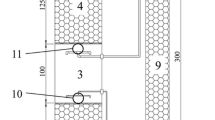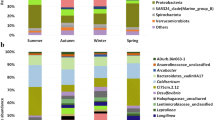Abstract
Biological hydrogen production through the anaerobic digestion is an environmental friendly alternative for satisfying future hydrogen demands. Microorganisms residing into waste water treatment plants are far from being exhaustively characterized and surveys on hydrogen production through FeFe-hydrogenase in such ecosystems are scarce. This study combined the analysis of 16S rRNA and [FeFe]-hydrogenase (hydA) genes with statistical tools to estimate richness and diversity of the microbial community of a domestic sewage treatment plant at the phylogenetic and functional levels. Archaeal groups were represented by 69 % of sequences assigned to Methanosarcinales and the remaining belonged to Methanomicrobiales. Within the bacterial library, 136 operational taxonomic units (OTUs) were distributed into 9 phyla, being 86 OTUs related to uncultivated bacteria. From these, 25 OTUs represented potential novel taxa within Synergistetes. Proteobacteria was the most predominant (36 % of the OTUs) and diversified phylogenetic group in the bacterial library, most of them assigned to the class Betaproteobacteria. Twenty-two putative hydA sequences were recovered into four distinct clusters and most of them were more closely related to each other than with sequences retrieved from databases, indicating they are hitherto undetected [Fe–Fe]-hydrogenase gene sequences. The richness estimates revealed that the number of sampled sequences was enough for full coverage of the archaeal diversity but not sufficient to cover both bacterial and hydA gene diversities. The results confirmed a great richness and diversity of bacterial and hydA sequences retrieved from the sewage sludge sample, suggesting such environment as a potential reservoir of new hydrogenase genes for biotechnological exploration.





Similar content being viewed by others
References
Ariesyady HD, Ito T, Yoshiguchi K, Okabe S (2007) Phylogenetic and functional diversity of propionate-oxidizing bacteria in an anaerobic digester sludge. Appl Microbiol Biotechnol 75:673–683
Boyd ES, Spear JR, Peters JW (2009) [FeFe] hydrogenase genetic diversity provides insight into molecular adaptation in a saline microbial mat community. Appl Environ Microbiol 75(13):4620–4623
Boyd ES, Hamilton TL, Spear JR, Lavin M, Peters JW (2010) [FeFe]-hydrogenase in Yellowstone National Park: evidence for dispersal limitation and phylogenetic niche conservatism. ISME J 4:1485–1495
Chojnacka A, Błaszczyk MK, Szczęsny P et al (2011) Comparative analysis of hydrogen-producing bacterial biofilms and granular sludge formed in continuous cultures of fermentative bacteria. Bioresour Technol 102:10057–10064
Chouari R, Le Paslier D, Daegelen P, Ginestet P, Weissenbach J, Sghir A (2005) Novel predominant archaeal and bacterial groups revealed by molecular analysis of an anaerobic sludge digester. Environ Microbiol 7:1104–1115
Chouari R, Le Paslier D, Daegelen P, Dauga C, Weissenbach J, Sghir A (2010) Molecular analyses of the microbial community composition of an anoxic basin of a municipal wastewater treatment plant reveal a novel lineage of proteobacteria. Microb Ecol 60:272–281
Dincer F, Muezzinoglu A (2008) Odor-causing volatile organic compounds in wastewater treatment plant units and sludge management areas. J Environ Sci Health, Part A 43:1569–1574
Ducey TF, Hunt PG (2013) Microbial community analysis of swine wastewater anaerobic lagoons by next-generation DNA sequencing. Anaerobe 1–8
Ewing B, Hillier L, Wendl MC, Green P (1998) Base-calling of automated sequencer traces using phred. I. Accuracy assessment. Genome Res 8:175–185
Fiandt M (2000) Construction of an environmental genomic DNA library from soil using the EpiFOS™Fosmid Library Production Kit. EPICENTRE forum, 7
Ganesan A, Chaussonnerie S, Tarrade A, Dauga C, Bouchez T, Pelletier E, Le Paslier D, Sghir A (2008) Cloacibacillus evryensis gen. nov., sp. nov., a novel asaccharolytic, mesophilic, amino-acid-degrading bacterium within the phylum ‘Synergistetes’, isolated from an anaerobic sludge digester. Int J Syst Evol Micr 58:2003–2012
Hesselsoe M, Füreder S, Schloter M, Bodrossy L, Iversen N, Roslev P, Nielsen PH et al (2009) Isotope array analysis of Rhodocyclales uncovers functional redundancy and versatility in an activated sludge. ISME J 3:1349–1364
Jaenicke S, Ander C, Bekel T, Bisdorf R, Dröge M, Gartemann K-H, Jünemann S et al (2011) Comparative and joint analysis of two metagenomic datasets from a biogas fermenter obtained by 454-pyrosequencing. PLoS ONE 6:e14519
Jiang HJ, Tay JH, Maszenan AM, Tay STL (2004) Bacterial diversity and function of aerobic granules engineered in a sequencing batch reactor for phenol degradation. Appl Environ Microbiol 70:6767–6775
Kalia VC, Lal S, Ghai R, Mandal M, Chauhan A (2003) Mining genomic databases to identify novel hydrogen producers. Trends Biotechnol 21:152–156
Kim JYH, Cha HJ (2013) Recent progress in hydrogenase and its biotechnological application for viable hydrogen technology. Korean J Chem Eng 30:1–10
Kimura MA (1980) Simple model for estimating evolutionary rates of base substitutions through comparative nucleotide sequences. J Mol Evol 16:111–120
Lane DJ (1991) 16S/23S rRNA sequencing. In: Stackebrandt E, Goodfellow MJ (eds) Nucleic acid techniques in bacterial systematics. Wiley, New York, pp 115–175
Larkin MA, Blachshields G, Brown NP, Chenna R, McGettigan PA, McWillian H, Valentin F, Wallace IM, Wilm A, Lopez R, Thompson JD, Gibson TJ, Higgins DG (2007) Clustal W and Clustal X version 2.0. Bioinformatics 23:2947–2948
Lin C-Y, Lay C-H, Sen B, Chu C-Y, Kumar G, Chen C-C, Chang J-S (2012) Fermentative hydrogen production from wastewaters: a review and prognosis. Int J Hydrogen Energy 37:15632–15642
Liu B, Zhang F, Feng X, Liu Y, Yan X, Zhang X et al (2006) Thauera and Azoarcus as functionally important genera in a denitrifying quinoline-removal bioreactor as revealed by microbial community structure comparison. FEMS Microbiol Ecol 55:274–286
Magurran AE (2004) Measuring biological diversity. Blackwell Publishing, Oxford
Mohan SV, Agarwal L, Mohanakrishna G, Srikanth S, Kapley A, Purohit HJ, Sarma PN (2011) Firmicutes with iron dependent hydrogenase drive hydrogen production in anaerobic bioreactor using distillery wastewater. Int J Hydrogen Energy 36:8234–8242
Nelson CM, Morrison M, Zhongtang Y (2011) A meta-analysis of the microbial diversity observed in anaerobic digesters. Bioresour Technol 102:3730–3739
Osaka T, Ebie Y, Tsuneda S, Inamori Y (2008) Identification of the bacterial community involved in methane-dependent denitrification in activated sludge using DNA stable-isotope probing. FEMS Microbiol Ecol 64:494–506
Rivière D, Desvignes V, Pelletier E et al (2009) Towards the definition of a core of microorganisms involved in anaerobic digestion of sludge. ISME J 3:700–714
Rodríguez E, Lopes A, Fdz-Polanco M, Stams AJM, García-Encina P (2012) Molecular analysis of the biomass of a fluidized bed reactor treating synthetic vinasse at anaerobic and micro-aerobic conditions. Appl Microbiol Biotechnol 93:2181–2191
Saitou N, Nei M (1987) The neighbor-joining method: a new method for reconstructing phylogenetic trees. Mol Biol Evol 4:406–425
Schloss P, Handelsman J (2005) Introducing DOTUR, a computer program for defining operational taxonomic units and estimating species richness. Appl Environ Microbiol 71:1501–1506
Schmidt O, Drake HL, Horn M (2010) Hitherto unknown [Fe–Fe]-hydrogenase gene diversity in anaerobes and anoxic enrichments from a moderately acidic fen. Appl Environ Microbiol 76:2027–2031
Silva CC, Viero AF, Dias ACF, Andreote FD, Jesus EC, Paula SOD, Torres APR et al (2010) Monitoring the bacterial community dynamics in a petroleum refinery wastewater membrane bioreactor fed with a high phenolic load. J Microbiol Biotechnol 20:17–25
Song M, Shin SG, Hwang S (2010) Methanogenic population dynamics assessed by real-time quantitative PCR in sludge granule in upflow anaerobic sludge blanket treating swine wastewater. Bioresour Technol 101:23–28
Stahl DA, Amann R (1991) Development and application of nucleic acid probes in bacterial systematics. In: Stackebrandt E, Goodfellow M (eds) Nucleic acid techniques in bacterial systematics. Wiley, Chichester, pp 205–248
Steinberg LM, Regan JM (2008) Phylogenetic comparison of the methanogenic communities from an acidic, oligotrophic fen and an anaerobic digester treating municipal wastewater sludge. Appl Environ Microbiol 74:6663–6671
Tamura K, Peterson D, Peterson N, Stecher G, Nei M, Kumar S (2011) MEGA5: molecular evolutionary genetics analysis using maximum likelihood, evolutionary distance, and maximum parsimony methods. Mol Biol Evol 28:2731–2739
Vignais Paulette M, Billoud B, Meyer J (2001) Classification and phylogeny of hydrogenases. FEMS Microbiol Rev 25:455–501
Wang H, Vuorela M, Keränen A-L, Lehtinen TM, Lensu A, Lehtomäki A, Rintala J (2010) Development of microbial populations in the anaerobic hydrolysis of grass silage for methane production. FEMS Microbiol Ecol 72:496–506
Xing D, Ren N, Rittmann BE (2008) Genetic diversity of hydrogen-producing bacteria in an acidophilic ethanol-H2-coproducing system, analyzed using the [Fe]-hydrogenase gene. Appl Environ Microbiol 74:1232–1239
Xu Shou-Ying, He P-Q, Dewi S-Z, Zhang X-L, Ekowati C, Liu T-J, Huang X-H (2013) Hydrogen-producing microflora and fe–fe hydrogenase diversities in seaweed bed associated with marine hot springs of Kalianda, Indonesia. Curr Microbiol. doi:10.1007/s00284-013-0302-0
Yoshida N, Yagi K, Sato D, Watanabe N, Kuroishi et al (2005) Bacterial communities in petroleum oil in stockpiles. J Biosci Bioeng 99:143–149
Zhou J, Xia B, Treves DS, Wu L-Y, Marsh TL, O’Neill RV, Palumbo AV, Tiedje M (2002) Spatial and resource factors influencing high microbial diversity in soil. Appl Environ Microbiol 61:326–334
Acknowledgments
G.T. was supported by grants from FAPESP (Fundação de Amparo à Pesquisa do Estado de São Paulo).
Author information
Authors and Affiliations
Corresponding author
Rights and permissions
About this article
Cite this article
Tomazetto, G., Oliveira, V.M. Investigation of the FeFe-hydrogenase gene diversity combined with phylogenetic microbial community analysis of an anaerobic domestic sewage sludge. World J Microbiol Biotechnol 29, 2003–2014 (2013). https://doi.org/10.1007/s11274-013-1363-8
Received:
Accepted:
Published:
Issue Date:
DOI: https://doi.org/10.1007/s11274-013-1363-8




